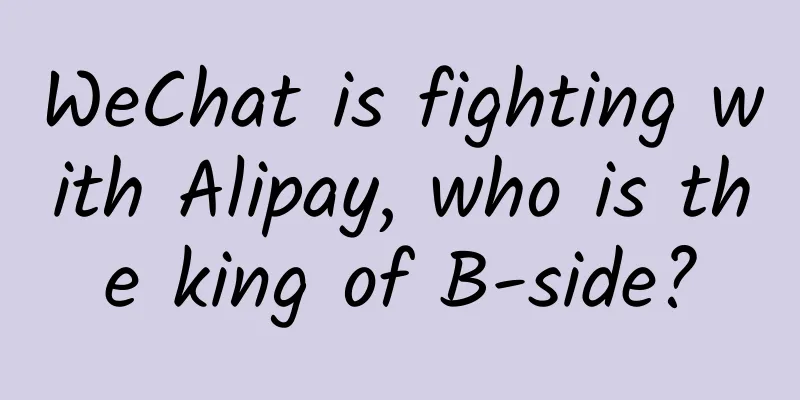WeChat is fighting with Alipay, who is the king of B-side?

|
Recently, there was a piece of news that attracted attention. Tucheng Town, Longchuan County, Heyuan City, Guangdong Province has become the first mobile payment demonstration town in Guangdong. The town has launched 90 projects in the fields of public transportation, medical health, and catering convenience. 137 merchants have received terminal transformation, with a completion rate of 95.6%, basically realizing the goal of traveling around the world with one mobile phone. Zhao Tuo was one of the commanders in the Qin Dynasty's southern expedition to the Baiyue Kingdom. He served as the magistrate of Longchuan and took advantage of the chaos in the late Qin Dynasty to proclaim himself king. He brought the Central Plains' advanced political system, agricultural technology, and cultural concepts to Lingnan, allowing the Nanyue Kingdom to remain in peace for a hundred years. Now that Longchuan County, a name that has lasted for two thousand years, is suddenly tied to the innovative concepts of mobile payment and cashless society, how much change will it bring to this ancient land? In fact, the penetration of mobile payment is an inevitable result. According to iResearch Consulting, the transaction volume of third-party mobile payment reached 190.5 trillion yuan in 2018, a year-on-year growth rate of 58.4%. People have gradually developed the habit of using mobile payment in their daily lives, and the penetration rate of third-party mobile payment has reached a very high level. Therefore, it is only a matter of time before more and more "Longchuan counties" are caught up in the wave of mobile payments in the future. However, there is another data in this report that cannot be ignored: the scale of third-party mobile payment transactions in Q1 2019 was 55.4 trillion yuan, a year-on-year growth rate of 24.7%. Compared with 95.7% in Q1 2018, this figure has almost shrunk to a quarter. Although the total transaction volume is increasing, the growth rate is declining. This actually illustrates one point: the Internet population traffic dividend is gradually fading, and the recent performance of mobile payments is also a sign of the changing tide. The Internet has entered the second half, and mobile payments have also entered the second half. Not long ago, Geng Zhijun, vice president of Tencent WeChat Business Group, publicly stated at the 88 Media Communication Conference that as the user scale of WeChat Pay has gradually peaked, the WeChat Pay team is currently facing outstanding work pressure, "Everyone is anxious about where we are going and how much we can grow." Chen Hao, founder of the aggregate payment platform Shouqianba, also admitted that within the visible range, most merchants are able to accept mobile payments, whether it is Alipay or WeChat’s own products, or products of aggregate payment service providers. They have touched all aspects of life, and mobile payments have truly entered the second half. What is the difference between the logic of the second half and the first half of mobile payment? To make an analogy, the first half was about educating users together, with banks, telecom operators and mobile phone manufacturers all trying to figure out how fast, comfortable and easy to use the mobile payment "train" is. The second half is about companies competing in car manufacturing capabilities and in-car soft furnishings and other hard strengths. If the first half of mobile payment was a strategic offensive phase, with all parties competing for traffic, which was a traffic war, then the second half entered a strategic stalemate phase, where players began to make use of existing traffic and dig deeper into scenarios through their own capabilities, which was a scenario war. Alipay and WeChat, the two “payment giants”, have actually realized this a long time ago. The reason why only these two are mentioned is that their combined market share exceeds 90%. It can be said that Alipay and WeChat’s understanding and strategy of the second half of mobile payment will determine the future direction of China’s mobile payment industry. WeChat: A desperate struggle for traffic In addition to reaching a consensus on "entering the second half", AT and AT have also focused their attention on the B-side field. The reason is very simple. Under the premise that the initial demand has been difficult to be tapped on a larger scale, tapping multiple demands for a single flow has become the next stage of the company's goal. If a consumption chain is likened to a river, then only when the upstream river channel is dug wider and deeper, or new tributaries flow in, can the downstream flow become more abundant and turbulent. This is exactly why the two giants have resolutely invested in the B-side field. However, this road is not easy for WeChat. Putting aside the genetic theory related to corporate culture, WeChat’s existing product attributes also determine this. WeChat is a social product. Social interaction is communication between people. In Internet terms, WeChat is a C2C platform in the field of communication. Because it is pure enough and easy to use, it can cover more levels of people and become the first super application with over 1 billion monthly active users. Merchants have also taken a fancy to this huge traffic advantage. Countless micro-business myths have confirmed the commercial value behind traffic. However, this abnormal business model that relies on traffic has destroyed the purity of WeChat and eroded its essential attributes as a social tool, so it has been sanctioned by the platform. Whether it is the folding of long copied texts in Moments or the previous heavy-handed blocking of thousands of accounts and the severe impact on private domain traffic, this has confirmed this point. Therefore, although WeChat Pay has repeatedly emphasized that it can provide marketing, data analysis and other capabilities accumulated by WeChat's one billion users, merchants are still interested in the "one billion users" themselves and want to harvest them with simple "massive exposure + conversion". Therefore, WeChat has to vigorously maintain the purity of its traffic and avoid excessive commercialization. I call this contradiction the "WeChat-style traffic dilemma." The best strategy is to attack the enemy’s mind. On the merchant side, WeChat Pay may have to tear off the “traffic” label before it can make a difference. WeChat Pay may have realized this crisis and has made some effective attempts to reconcile the conflict between C and B, payment points being one example. The logic and usage scenarios of WeChat Pay are similar to those of Sesame Credit. While lowering the threshold for C-end users, it also reduces the business risks of B-end merchants. However, there are not many application scenarios and the scale is not large enough. In addition, most of the applicable scenarios are already blocked by Sesame Credit, which is indeed a first-mover advantage that WeChat Pay is difficult to catch up with. Alipay: Self-evolution of To B genes It is a recognized fact that Alipay or the entire Alibaba ecosystem understands business better. On the one hand, Alipay itself focuses on "transactions and services", so Alipay is essentially a B2C platform, and these services are mainly provided by the Alibaba ecosystem and its partners. Therefore, the objects of Alipay's services have always included both B and C aspects. Therefore, a series of capabilities within the Alipay ecosystem, such as pre-transaction marketing, risk control, credit system, transaction methods during transactions, post-transaction logistics and after-sales, etc., all revolve around business, are based on payment, and have exploded with strong commercial potential in all walks of life. Take the car rental industry as an example. Car rental itself is a low-frequency consumption, and the high deposit is the last straw that breaks the camel's back. But without a deposit, the loss cannot be guaranteed and the risk is too high. Therefore, when Sesame Credit came out, this major pain point was solved. According to iResearch's "User Insights into the Car Rental Industry", among the main car rental users aged 18-35, 70.6% of users prefer Alipay for car rental payments because they can use Sesame Credit to avoid deposits. Another interesting data is that among offline car rental users, 94.1% are willing to switch to online payment because online payment can avoid deposits. The significance of switching from offline to online is that all consumer behaviors become visible, making it possible to operate users in depth. On the other hand, Alipay’s business potential also lies in the cross-combination of these capabilities, deep exploration of business scenarios and creation of new business variables. A simple example is that the main business of "Guma Recycling" is the recycling of 3C digital products. The unit price of recycling this type of products is high, so it is connected to Sesame Credit. According to different credit levels, a certain amount of funds will be prepaid to users, and up to the full amount can be prepaid, which lowers the psychological threshold of users. But the problem is that Sesame Credit is based on people, and the scores are bound to identity information. If someone registers a new account with the same identity and obtains the platform's prepayment with false information, and then abandons the account, the platform has no way to recover the funds, resulting in bad debts. Therefore, "Guma Recycling" is connected to the account security capability of Alipay's risk control. This capability is based on the account dimension and provides B-side merchant account risk levels. Only accounts with a safe level can see the Sesame Credit prepayment function. The combination of the two can minimize the bad debt rate. This is a very small business scenario, but often a deep understanding of business is embedded in these tiny details; perhaps this is the so-called "2B gene." To win the next war, what Alipay needs to do is to evolve this gene again and again and strive for absolute advantage. Some media recently threw the anxiety problem to WeChat and Alipay respectively. Geng Zhijun, vice president of WeChat Pay, said that the WeChat Pay team is under great pressure and is anxious about where to go and how much they can grow. Zhong Yao, general manager of Alipay IoT Division, said that Alipay does not have growth anxiety at present. If there is any anxiety, it is about how to create greater value for merchants and business ecosystem. This precisely reflects the change of course, the hidden worries brought about by WeChat's social traffic is not omnipotent, and Alipay's desire for B-side service innovation. Of course, it is a bit wrong to judge success or failure only by whether or not there is a 2B gene. Keso also thinks, "Does it mean that Tencent cannot do cloud computing and industrial Internet well if it says that Tencent does not have a to B gene? No, it means that without a to B gene, it will be very difficult and reluctant to do to B things. It is precisely because it is so difficult that Tencent is so determined to fully enter the industrial Internet and is determined to do it." How WeChat Pay will attack Alipay will be one of the most exciting highlights in the second half of mobile payment. |
<<: 15 little-known facts about WeChat, there is always one you don’t know
Recommend
10 small price setting strategies to double your conversions
Product price is an important factor in users’ de...
Taobao Live Competitive Product Analysis and Optimization Strategy
In recent years, the integration of live streamin...
All the strategies for advertising on new media platforms in 2018 are here!
According to the data from the "2018 China O...
BMW China is unable to remit profits from China, rumor refuted by many parties
I believe most people know that the profits of jo...
Deep learning: preconceptions, limitations, and the future
I know it's a weird blog title to use a negat...
Top 20 Marketing Pain Points for Advertisers
For advertisers , marketing and advertising decis...
What kind of plant is Stephania? Is it true that cephalothin can treat COVID-19?
Recently, Qianjinteng suddenly became popular bec...
Military Advisor's Office Four Pillars Learning Elementary and Intermediate Class
Resource introduction of the Military Advisor'...
Breaking news! First detection in mainland China!
Tianjin detects the Omicron variant of the novel ...
6 data truths about Kuaishou live streaming sales
If we say that there are already three top stream...
YotaPhone: Learning from Xiaomi in China
During the coldest winter in China’s mobile phone...
Replica of the "precision eye"! New crystal material can expand the field of view to 360 degrees
Popular Science Times (Intern Wang Yuke) The inte...
Guinness World Records names the most dangerous bird, which can kick through steel plates
This bird can kick through a human's stomach,...
What data indicators should APP operation focus on?
There are many types of APPs on the market, and e...
Data shows iPhone users are in no rush to update from iOS 14 to iOS 15
In September, Apple launched the iOS 15 software ...









